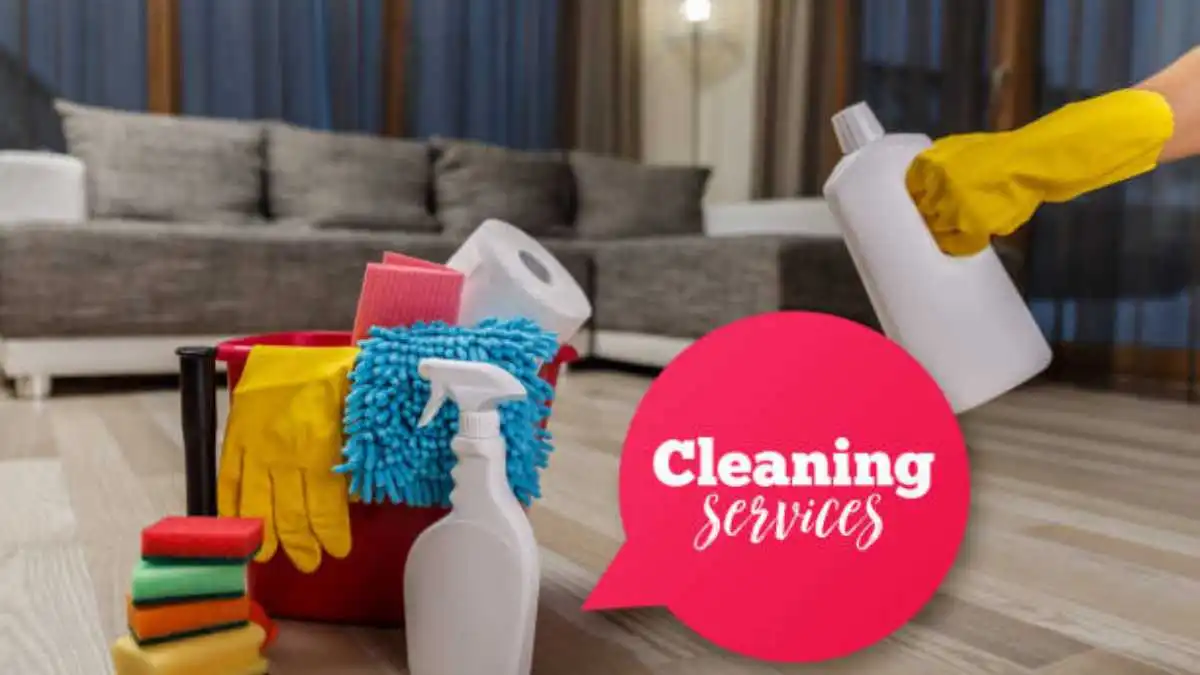SERVICES
Essential Differences between Standard Cleaning and Deep Cleaning for Your Home

Maintaining a clean home requires consistent effort, but not all cleaning tasks are the same. Some involve daily or weekly upkeep, while others require more intensive, occasional work. Understanding the difference between standard cleaning and deep cleaning is essential for keeping your home both presentable and hygienic. Each serves a distinct purpose, and both are important for a comprehensive home maintenance routine.
In this article, we’ll explore the key differences between standard cleaning and deep cleaning, why each is important, and how they work together to maintain a clean, healthy living environment.
Table of Contents
1. What is Standard Cleaning?
Standard cleaning refers to the routine, surface-level tasks that help keep your home looking neat and tidy on a daily or weekly basis. This type of cleaning focuses on maintaining order and cleanliness in high-use areas like living rooms, kitchens, and bathrooms. While it doesn’t involve scrubbing or detailed work, it keeps dirt and clutter from accumulating over time.
Common Tasks in Standard Cleaning:
- Dusting and Wiping Surfaces: Regularly wiping down tables, countertops, and furniture removes dust, crumbs, and spills, preventing buildup. This is a quick and easy way to maintain cleanliness on a day-to-day basis.
- Vacuuming and Sweeping Floors: Floors, especially in high-traffic areas, accumulate dirt and debris quickly. Vacuuming carpets and sweeping hard floors are essential to keeping these areas clean and free of dust.
- Bathroom Maintenance: Standard cleaning of the bathroom includes wiping down sinks, counters, mirrors, and cleaning the toilet. Regular upkeep of these areas ensures that they remain hygienic and ready for use.
- Emptying Trash Bins: Emptying trash cans in kitchens, bathrooms, and living areas prevents odors and keeps the home clutter-free.
Standard cleaning is typically done on a regular basis—weekly or biweekly—to maintain cleanliness and prevent larger messes from forming. It’s a manageable routine that helps you stay on top of everyday dirt and clutter.
2. What is Deep Cleaning?
Unlike standard cleaning, deep cleaning involves more intensive, thorough tasks that target the hidden dirt, grime, and germs that accumulate over time. Deep cleaning goes beyond surface-level cleaning and focuses on areas that are often neglected during regular cleaning routines. It’s essential for maintaining a truly hygienic environment, especially in areas that don’t see daily attention.
Key Tasks in Deep Cleaning:
- Cleaning Under Furniture and Appliances: Deep cleaning involves moving heavy furniture like couches, beds, and appliances to vacuum and clean underneath. Dust, pet hair, and debris can accumulate in these hidden spots, creating an unhealthy environment if left unaddressed.
- Scrubbing Grout and Tiles: Over time, grout in bathrooms and kitchens can become stained or moldy. Deep cleaning includes scrubbing grout lines and tiles to restore their appearance and prevent mildew buildup.
- Washing Baseboards and Trim: Baseboards, door frames, and crown molding often collect dust and dirt that goes unnoticed in standard cleaning. Wiping down these areas during a deep clean enhances the overall cleanliness of the home.
- Deep Cleaning Carpets: Carpets hold onto dirt, allergens, and pet dander that regular vacuuming can’t fully remove. A deep clean may include shampooing or steam cleaning carpets to eliminate these deeper layers of grime.
Deep cleaning is usually done less frequently than standard cleaning—typically every few months or during seasonal changes. It’s a more intensive process that focuses on sanitizing and rejuvenating areas that don’t get regular attention.
3. When to Choose Standard Cleaning vs. Deep Cleaning
Knowing when to opt for standard cleaning versus deep cleaning depends on the condition of your home and your cleaning goals. Both have their place in a comprehensive cleaning routine, but their purposes and frequency differ.
When to Opt for Standard Cleaning:
- Regular Upkeep: Standard cleaning is ideal for maintaining a home’s appearance and cleanliness on a day-to-day or weekly basis. It’s a quick way to tidy up and ensure that the home is presentable for daily use or guests.
- High-Traffic Areas: Rooms like the living room, kitchen, and bathrooms often need regular cleaning to prevent dirt from piling up. Standard cleaning addresses these frequently used spaces and ensures they remain clean and functional.
- Limited Time: If you’re short on time, standard cleaning allows you to focus on the most important areas of your home, keeping it manageable without requiring hours of effort.
When to Opt for Deep Cleaning:
- Seasonal Cleaning: Many homeowners choose to deep clean their homes during specific times of the year, such as spring or fall. Deep cleaning during these periods helps refresh the home and eliminates dirt that has accumulated over several months.
- After Special Events or Occasions: Hosting parties or events can leave your home messier than usual. Deep cleaning after such occasions ensures that every area is restored to its original cleanliness.
- Before or After Moving: Move-in/out cleaning is a critical deep-cleaning task that ensures a space is spotless before new occupants move in or after you move out. It’s the perfect time to clean areas that might not get regular attention during standard cleaning routines.
Both standard cleaning and deep cleaning serve essential roles, but they are used at different times based on the specific needs of your home.
4. Benefits of Deep Cleaning Beyond Surface Cleaning
While standard cleaning keeps your home looking neat and organized, deep cleaning offers benefits that go beyond surface-level tidiness. By addressing hidden areas and focusing on detailed cleaning, deep cleaning helps improve the overall hygiene and comfort of your living environment.
Why Deep Cleaning is Essential:
- Improved Air Quality: Dust, allergens, and pet dander can accumulate in places that aren’t addressed by regular cleaning. Deep cleaning helps remove these particles, improving the air quality in your home and reducing allergy symptoms.
- Eliminating Germs and Bacteria: High-touch areas like light switches, doorknobs, and faucets can harbor germs that are not always addressed during standard cleaning. Deep cleaning involves disinfecting these surfaces, reducing the spread of bacteria and viruses in your home.
- Prolonging the Life of Surfaces and Furniture: Dirt and grime can wear down surfaces, floors, and furniture over time. Regular deep cleaning helps preserve the condition of these items, extending their lifespan and reducing the need for repairs or replacements.
- Enhanced Aesthetic Appeal: A deep-cleaned home looks and feels fresher. Cleaning often-overlooked areas like windows, baseboards, and light fixtures can make your home feel brighter and more inviting.
Deep cleaning is an important part of maintaining a healthy and comfortable living space, ensuring that your home is not only clean on the surface but also free from hidden contaminants.
5. Creating a Balanced Cleaning Schedule
To maintain a clean and healthy home, it’s important to strike a balance between standard cleaning and deep cleaning. Developing a cleaning schedule that incorporates both types of cleaning ensures that your home remains tidy in the short term while receiving a thorough refresh when needed.
How to Create a Balanced Cleaning Schedule:
- Daily or Weekly Standard Cleaning: Focus on high-traffic areas like kitchens, bathrooms, and living spaces with standard cleaning tasks. These areas should be cleaned on a regular basis to maintain cleanliness and prevent dirt from building up.
- Monthly or Seasonal Deep Cleaning: Schedule deep cleaning tasks every few months to target areas that need more attention. You can divide the work over time by focusing on different rooms or areas of your home, such as deep-cleaning the kitchen one month and tackling the bathrooms the next.
- Prioritize Based on Needs: If certain areas of your home tend to accumulate more dirt or require more maintenance, prioritize those spaces for regular deep cleaning. For example, homes with pets may need more frequent carpet cleaning, while bathrooms may require more attention to grout and tile.
By combining routine standard cleaning with periodic deep cleaning, you can maintain a home that is not only clean on the surface but also thoroughly sanitized and organized.
6. How Professional Cleaning Services Can Help
Balancing standard cleaning and deep cleaning on your own can be time-consuming, especially for larger homes or busy households. Professional cleaning services can take this burden off your shoulders by handling both regular and deep cleaning tasks with expert care.
Benefits of Professional Cleaning Services:
- Consistent Results: Professional cleaners have the experience and tools to ensure that every cleaning task is completed to a high standard, whether it’s a quick weekly clean or an intensive deep clean.
- Time-Saving: Hiring professionals for deep cleaning allows you to focus on other responsibilities while ensuring that your home is thoroughly cleaned. This is especially helpful for deep cleaning tasks that require more time and effort.
- Specialized Cleaning Products and Equipment: Professional cleaners use high-quality products and equipment designed for deep cleaning, ensuring that all surfaces, carpets, and hidden areas are properly sanitized.
For those looking to maintain a clean home without the hassle of managing everything themselves, professional cleaning services like Honeycomb Home Cleaning offer both standard cleaning and deep cleaning solutions to keep your home in pristine condition year-round.
Conclusion
Understanding the difference between standard cleaning and deep cleaning is key to maintaining a clean, healthy, and comfortable home. While standard cleaning helps keep things tidy on a regular basis, deep cleaning addresses hidden dirt, grime, and allergens that can accumulate over time. By incorporating both into your routine and knowing when to use each, you can enjoy a home that’s not only presentable but also truly clean.
Whether you choose to tackle these tasks yourself or hire a professional service like Honeycomb Home Cleaning, maintaining the right balance between standard and deep cleaning will keep your home fresh and hygienic, making it a healthier place for you and your family.
-

 GENERAL4 months ago
GENERAL4 months agoChristofle – For Those Who Dream of Family Heirloom Silver
-

 SPORTS6 months ago
SPORTS6 months agoDiscover the World of Football with Streameast: Watch Your Favorite Leagues and Tournaments
-

 GENERAL3 months ago
GENERAL3 months agoUncovering the World of кинокрадко: The Dark Side of Film Piracy
-

 GENERAL2 months ago
GENERAL2 months agoUnveiling the Art of преводсч: How Translators Bridge Language Barriers




























